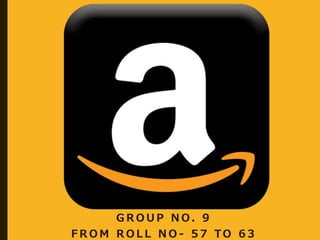
Amazon's strategy for logistics and transportation in India
- 1. G R O U P N O. 9 F R O M R O L L N O - 5 7 TO 6 3
- 2. AN OVERVIEW Tagline Globallyas - . “From A to Z” (get any product online from A to Z) In India - “ #Aur Dikhao” Jeffrey Preston Bezos, a well known retail entrepreneur, investor, and philanthropist , chairman and chief executive officer of “Amazon”. Launched in 1995 as a website that sold only books. Which still today remain loyal to its roots (by selling all genre books to its loyal reader’s). Being a voracious reader himself, he wanted to name his company with a magical flair as ‘Cadabra’ (from the word Abracadabra). But finally he ended up with the name Amazon.
- 3. INTRODUCTION An American multinational company. Incorporated in 1994 by Jeff Bezos. In July 1995, sold its first book on Amazon.com In 1998, Acquired Junglee.com In 2012, Entered Indian E- Commerce space as junglee.com In 2013, Launched Amazon.in
- 4. AMAZON – ENTRY TO INDIAN MARKET Amazon designed an eye catching ‘Chai Cart’, which could easily move through the narrow streets of Indian markets informing Sellers about the benefits of starting an online business and helping them understand the entire process over a cup of Chai. In a period of 4 months, the team travelled 15,280 km across 31 cities, served 37,200 cups of tea and engaged with over 10,000 sellers. Since its launch in June 2013, they have reached sellers in 25 cities.
- 5. THE GAME PLAN OF AMAZON INDIA: WINNING INDIA
- 6. INDIA: THE BIG OPPORTUNITY FOR AMAZON
- 7. AMAZON – THE EVOLUTION INITIALLY
- 8. AMAZON – THE EVOLUTION AS OF NOW
- 9. AMAZON FINANCIAL ANALYSIS Amazon announced their revenue for the 4th quarter of 2017 and with that, we found their overall revenue of 2017. AWS arm proved to be the most profitable segment racking in more than $4 billion operating income alone leading to record-breaking sales in 2017. Amazon operations, from the revenue perspective, can be divided into three major segments: North America, International, and AWS.
- 11. PROBLEM STATEMENT – LOGISTICS & TRANSPORTATION Amazon has largest warehouses across the globe and India. Over the past four years Amazon has been quietly building its warehousing and logistics business in India — the brick and mortar foundation behind Amazon’s virtual mall where millions of buyers shop for almost everything from jewellery to clothes to phones to washing machines and grocery. Amazon uses third-party logistics firms including “GATI, Blue Dart and FedEx Corp” as they does not have their own logistics services whereas Flipkart has their own logistics services called “E-Kart”.
- 12. Amazon mostly uses air shipment for delivering products across India. Whereas in order to reduce air shipments, Flipkart is setting up regional warehouses and signing up more suppliers across the country to ensure customers get orders delivered by the nearest supplier. This results in increase of transportation costs which ultimately increases the price of product. PROBLEM STATEMENT – LOGISTICS & TRANSPORTATION
- 15. IMPACT OF THIRD PARTY LOGISTICS Amazon Flipkart
- 16. Looking at the current business scenario Amazon is growing at a very fast pace and will be needing more warehouses to store products. Instead of purchasing more warehouses and increasing their fixed cost they can rent a warehouse or use any public warehouses available thereby saving up on a maintenance cost of a warehouse. They can also focus on ‘Just In Time’ (JIT) approach thereby minimizing the inventory levels and saving up on the cost of purchasing or renting a new warehouse. SOLUTION TO THE PROBLEM
- 17. Like Flipkart, Amazon can also start its own logistics services for delivering its products to consumers as this will help them to reduce their transportation costs. Having own logistics service will not only help them to reduce the transportation cost but will also help them fast delivery of products to consumers. Instead of frequently using air transport they can make more use of Rail networks in order to save on cost and avoid damages occurring due to extensive product handling in air shipment. Reduction of costs will lead Amazon to be more competitive in market and can use the saved funds in other business activities or business expansion. SOLUTION TO THE PROBLEM
- 18. ANALYSIS OF QUANTITATIVE STRATEGIC PLANNING Logistic management: About 60% of online sales come from tier two cities. To reach the customers quickly company needs to have an effective logistic management. Flipkart seems to be Amazon’s only real competition. Flipkart’s quick delivery system has led to large Flipkart loyalists. Diversification: Diversifying into other products will help the company to check the entry of competitors which e.g. going into food, clothes etc. so that expenses are also distributed and adverse conditions in one sector can be borne by other one.
- 19. Innovation: Only pricing cannot be taken as a differentiating factor, innovation is also needed. The company should create a total buying experience that has been missing in the Indian context. Promotion should be done through Push and Pull strategies which will include offers and advertising. ANALYSIS OF QUANTITATIVE STRATEGIC PLANNING
- 21. THANK YOU PRITESH PANCHAL 57 PRIYA PANKAR 58 RIGANBEN PANSERIA 59 KOMAL PARMAR 60 MAHESH PARMAR 61 DIPAKKUMAR PATEL 62 NILESH PATHAK 63
